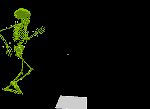
Friedrich-Alexander-Universität Erlangen
Lehrstuhl für Mustererkennung
Martensstraße 3
91058 Erlangen

My PhD project focuses on the correction of involuntary motion during C-arm CT scans using biomechanical modeling.
Osteoarthritis (OA) is the leading cause of functional decline and disability in aging populations. Its causes and progression in the early stages remain poorly understood. The main disadvantages of current OA imaging systems are that they fail to provide information about early changes and that they require long scan times.
A novel approach to quantitatively analyze the knee joint is pursued in this project. The overarching goal is to develop a computed tomography (CT) imaging method to scan the patients in a standing/squatting and thereby weight-bearing position. This can help to further understand the mechanical stresses on the knee joint that affect cartilage and meniscus health. The scanner used in the project is a flexible C-arm CT that is able to run a horizontal trajectory.
However, scanning the patients in a standing or squatting position will lead to involuntary motion of the knees during the scan. This motion will result in artifacts in the reconstruction that reduce the diagnostic image quality. Different approaches to compensate the motion have already been investigated in previous parts of the project.
The project is in collaboration with the ![]() Department of Radiology, Stanford University, Stanford, CA, USA.
Department of Radiology, Stanford University, Stanford, CA, USA.![]()
For details, please see my ![]() projects page.
projects page.
I am a member of the research training group for heterogeneous imaging systems (RTG 1773). For mor information click ![]() here.
here.

The division medical image processing investigates problem statements in ![]() image registration, reconstruction,
image registration, reconstruction, ![]() segmentation,
segmentation, ![]() X-ray phase contrast and image analysis.
X-ray phase contrast and image analysis.

Digital Sports is a new emerging field within computer science. We are about to develop novel digital support systems for top athletes in close collaboration with sports industry.